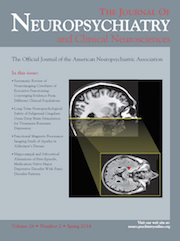Systematic Review of Neuroimaging Correlates of Executive Functioning: Converging Evidence From Different Clinical Populations
Abstract
Executive functioning (EF) is an important cognitive domain that is negatively affected in a number of neuropsychiatric conditions. Neuroimaging methods have led to insights into the anatomical and functional nature of EF. The authors conducted a systematic review of the recent cognitive and neuroimaging literature to investigate how the neuroimaging correlates of EF compare between different diagnostic groups. The authors found that the frontal, parietal, and cerebellar lobes were most frequently associated with EF when comparing results from different clinical populations; the occipital lobe was not correlated with EF in any group. These findings suggest that individual disease processes affect circuits within an identifiable distributed network rather than isolated regions.



